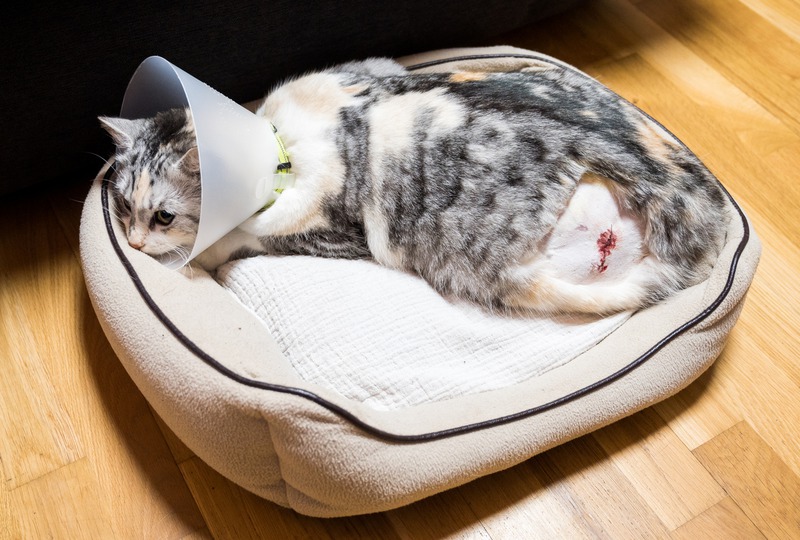Post-surgical care is crucial for pets’ quick recovery and well-being after surgery. It’s a period any pet owner must approach with great understanding and responsibility. It involves providing the necessary attention, comfort, nutrition, and medical treatment to help the pet recover seamlessly. Post-surgical care is crucial for ensuring your pet’s comfort, promoting healing, and minimizing the risk of complications following surgery. Here’s how post-surgical care is typically managed for pets at home:
1. Follow Veterinarian’s Instructions
-
Your vet surgeon specialist will provide comprehensive post-operative care instructions tailored to your pet’s specific surgery, medical condition, and individual needs.
-
These instructions may include details on wound care, medication administration, activity restrictions, dietary guidelines, and signs of potential complications to watch for.
-
Your veterinarian’s guidance is essential for ensuring your pet’s comfort, safety, and optimal recovery, so following their recommendations closely is crucial.
2. Monitor Incision Site
-
Regular monitoring of the incision site is vital for detecting any signs of infection, inflammation, or other complications early.
-
Follow your veterinarian’s instructions for how often to check the incision site, what abnormalities to look for, and when to contact them if you notice any concerning changes.
-
Keep the incision site clean and dry, and avoid applying topical treatments or substances unless specifically instructed by your veterinarian.
3. Administer Medications
-
Administering prescribed medications as directed is essential for managing pain, preventing infection, and promoting healing.
-
Follow your veterinarian’s dosing instructions carefully and ensure your pet receives each medication at the prescribed time and dosage.
-
If you have any questions or concerns about administering medications, don’t hesitate to contact your veterinarian for clarification or assistance.
4. Provide Comfort and Rest
-
Create a calm, quiet, and comfortable environment for your pet to rest and recover at home.
-
Offer soft bedding or blankets in a cozy, secluded area away from noise, disturbances, and other pets.
-
Minimize handling or disturbances that may cause stress or discomfort for your pet, allowing them to rest undisturbed as much as possible.
5. Prevent Licking or Chewing
-
Preventing your pet from licking, chewing, or scratching at the incision site is crucial for preventing irritation, infection, or wound breakdown.
-
Use an Elizabethan collar (cone collar) or other protective devices, as veterinary services in Stuart, FL, recommends preventing your pet from accessing the surgical site.
-
Monitor your pet closely to ensure they cannot remove or damage the collar, and adjust it as needed for a proper fit.
6. Diet and Hydration
-
Offer your pet small, frequent meals of their regular diet to prevent gastrointestinal upset and promote recovery.
-
Ensure your pet has access to fresh water and encourage them to drink to prevent dehydration, especially if they take medications that may cause increased thirst.
-
If your pet has dietary restrictions or special dietary needs following surgery, follow your veterinarian’s recommendations regarding feeding and nutrition.
7. Gradual Return to Normal Activities
-
Gradually reintroduce your pet to their normal activities and routine as they recover from surgery.
-
Start with short periods of gentle activity and gradually increase duration and intensity as tolerated by your pet.
-
Avoid strenuous exercise, jumping, or rough play during the initial recovery period to prevent strain on the surgical site and promote optimal healing.
8. Attend Follow-Up Appointments
-
Schedule and attend any follow-up appointments with your veterinarian as recommended. You can also bring your pets for newborn puppy vaccinations during your follow-up.
-
These appointments allow your veterinarian to monitor your pet’s progress, assess the healing of the surgical site, and address any concerns or complications that may arise.
-
Follow your veterinarian’s instructions regarding suture removal, wound rechecks, and additional treatments or follow-up care that may be necessary.
9. Observe Behavior and Appetite
-
Pay close attention to your pet’s behavior, appetite, and overall demeanor during recovery.
-
Look for signs of pain, discomfort, lethargy, or changes in behavior that may indicate complications or discomfort.
-
Monitor your pet’s appetite and ensure they eat and drink adequately, as decreased appetite or refusal to eat may indicate underlying issues.
10. Communicate with Your Veterinarian
-
Maintain open lines of communication with your veterinarian throughout the post-surgical recovery process.
-
Inform your veterinarian of any changes in your pet’s condition, response to treatment, or concerns you may have.
-
Your veterinarian can provide guidance, support, and adjustments to the post-operative care plan as needed to ensure the best possible outcome for your pet.
Wrapping Up
The successful management of post-surgical care for pets at home entails a blend of correct medical practices, proper diet, adequate rest, regular monitoring, and emotional support. Pet owners have a crucial role in their pets’ recovery process by creating a serene environment, following the vet’s guidelines, and looking out for any signs of complications. It’s essential to remember that each pet may respond differently post-operation, and their recovery rate may vary depending on their health status and the complexity of the procedure.





